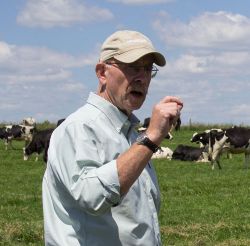
There is, however, a third leg to this tripod that often defines success or failure in a countless number of ways and garners our attention on a daily basis. That third leg is water — two little hydrogen atoms covalently bonded to oxygen that often cause extreme emotional highs and lows.
As I travel around the country visiting farms and ranches, there are easily noticeable differences in soils and the crops that they grow. What is universal is our dependency on water, but not just to grow crops.
We usually think of water in terms sustaining crop growth, which it does either by natural rainfall or irrigation. Both too much water and too little water are detrimental to productivity; however, for forage producers, water takes on a level of importance beyond that just needed for crop growth. Grazing aside, much of what we do in the forage industry and how we do it resides in the concentration of internal plant moisture at harvest.
Working to attain an acceptable harvest moisture range is responsible for a lot of farmer angst and out-of-pocket investment. It’s a necessary evil that dictates how and when we harvest. Hitting the optimum moisture harvest range has caused countless farmers and ranchers to miss many Memorial Day and Fourth of July picnics.
Here’s the thing about the harvest moisture of forage crops: It is not only paramount to governing the way it will store, but it can also be critical to forage quality. In the arid West, some producers use “steamers,” at great expense, to put moisture back into the wilted forage; it’s not because the bone-dry hay won’t store but instead to save leaves and ensure quality.
In the more humid East, investments are made in conditioners, tedders, and rakes to help drive moisture out of the crop. Even so, there is still the need to use organic acids to help preserve a wetter than desired crop.
For corn silage, whole plant moisture not only singularly drives the harvest-timing decision, but it also dictates final crop quality from both a plant and storage standpoint.
If your farm is located in a humid environment or one blessed with frequent rain events, it’s difficult to put up high-quality dry hay. That’s why nearly all Midwest and Northeast dairies have chosen the chopped haylage route for many years now. It’s also responsible for the most significant, recent trend change in forage harvesting — baleage.
I see baleage nearly everywhere I travel. It has shortened the necessary wilting time in half (or more) compared to dry hay and has the added benefit of improved forage quality. “Revolutionary for the small producer” is how Ben Bartlett describes baleage in our page 10 story.
Finally, for any high-moisture forage that’s harvested, internal plant moisture is the single biggest factor that drives optimum fermentation. Push the limits, either too dry or too wet, and you’ll pay a significant price.
The whims of water are an agricultural reality. For forage producers, they’re much, much more.
This article appeared in the April/May 2019 issue of Hay & Forage Grower on page 4.
Not a subscriber? Click to get the print magazine.

